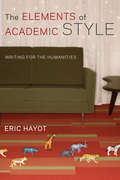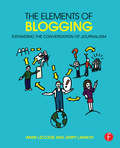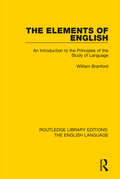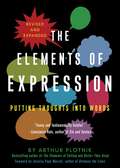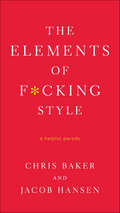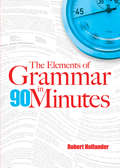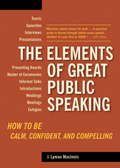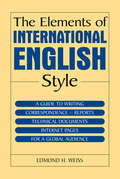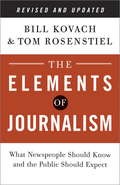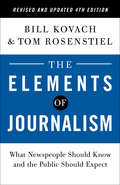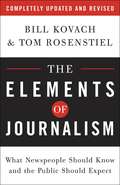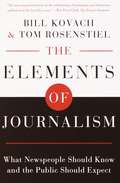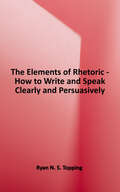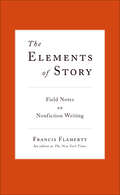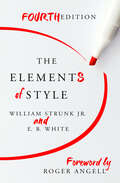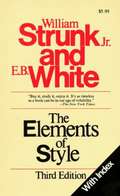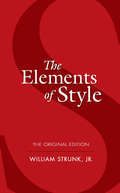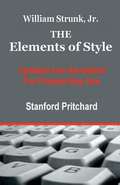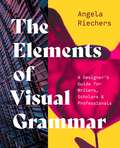- Table View
- List View
The Elements of Academic Style: Writing for the Humanities
by Eric HayotEric Hayot teaches graduate students and faculty in literary and cultural studies how to think and write like a professional scholar. From granular concerns, such as sentence structure and grammar, to big-picture issues, such as adhering to genre patterns for successful research and publishing and developing productive and rewarding writing habits, Hayot helps ambitious students, newly minted Ph.D.'s, and established professors shape their work and develop their voices.Hayot does more than explain the techniques of academic writing. He aims to adjust the writer's perspective, encouraging scholars to think of themselves as makers and doers of important work. Scholarly writing can be frustrating and exhausting, yet also satisfying and crucial, and Hayot weaves these experiences, including his own trials and tribulations, into an ethos for scholars to draw on as they write. Combining psychological support with practical suggestions for composing introductions and conclusions, developing a schedule for writing, using notes and citations, and structuring paragraphs and essays, this guide to the elements of academic style does its part to rejuvenate scholarship and writing in the humanities.
The Elements of Academic Style: Writing for the Humanities
by Eric HayotEric Hayot teaches graduate students and faculty in literary and cultural studies how to think and write like a professional scholar. From granular concerns, such as sentence structure and grammar, to big-picture issues, such as adhering to genre patterns for successful research and publishing and developing productive and rewarding writing habits, Hayot helps ambitious students, newly minted Ph.D.'s, and established professors shape their work and develop their voices.Hayot does more than explain the techniques of academic writing. He aims to adjust the writer's perspective, encouraging scholars to think of themselves as makers and doers of important work. Scholarly writing can be frustrating and exhausting, yet also satisfying and crucial, and Hayot weaves these experiences, including his own trials and tribulations, into an ethos for scholars to draw on as they write. Combining psychological support with practical suggestions for composing introductions and conclusions, developing a schedule for writing, using notes and citations, and structuring paragraphs and essays, this guide to the elements of academic style does its part to rejuvenate scholarship and writing in the humanities.
The Elements of Alternate Style: Essays on Writing and Revision
by Wendy BishopElements of Alternate Style contributes to a better understanding of the writing process in general and the stylistic options available to every serious writer. It demonstrates how by teaching alternate and traditional styles in tandem, by focusing on revision as invention, we can help students become newly engaged with their texts-even "school writing. " In this edited collection, successful classroom instructors explore and apply these ideas, drawing from composition pedagogy, creative writing technique, and critical theory. The six essays in Part I delineate an initial classroom sequence. . The authors ask writers to try writing exercises and to reconsider how they have constructed essays in the past-how they might reconstruct them today by looking and looking again, by fracturing and creating double voices, by reconsidering the place of research. Part II pushes these explorations further in five essays that contend that writing is about taking risks, trying (sometimes failing), learning from exploration, from play, from radical twists and turns. Part III engages even broader issues of identity, technology, correctness, and editing. Elements of Alternate Style is a powerful, liberating resource that validates innovative writing instruction and offers a rich array of voices and techniques.
The Elements of Blogging: Expanding the Conversation of Journalism
by Mark Leccese Jerry LansonBecoming a blogger takes practice, hard work, and, ultimately, a passion for the craft. Whether you plan to blog on politics or parenting, The Elements of Blogging is designed to give you the skills and strategies to get started, to sustain your work, and to seek out a robust audience. This book is loaded with practical advice on important topics such as determining a niche, finding the best stories, and blogging effectively and ethically. It features examples from both amateur and professional bloggers that show the techniques for building an argument, finding a voice, crafting a headline, and establishing a brand. Key features: Real-world applicability. This book includes thumbnail profiles of bloggers and their sites, which illuminate key skills you will need to become an effective blogger Interactivity. Each chapter features discussion points and exercises intended to get you to think about, reflect on, and apply the contents of each chapter Creativity. While this book dives into software and plug-ins for bloggers, its main goal is to cover how to write blogs on a myriad of topics: news, opinion pieces, travel, politics, art, and more. Visit the companion website: http://www.theelementsofblogging.com/
The Elements of Eloquence
by Mark ForsythFrom classic poetry to pop lyrics, from Charles Dickens to Dolly Parton, even from Jesus to James Bond, Mark Forsyth explains the secrets that make a phrase--such as "O Captain! My Captain!" or "To be or not to be"--memorable. In his inimitably entertaining and wonderfully witty style, he takes apart famous phrases and shows how you too can write like Shakespeare or quip like Oscar Wilde. Whether you're aiming to achieve literary immortality or just hoping to deliver the perfect one-liner, The Elements of Eloquence proves that you don't need to have anything important to say--you simply need to say it well. In an age unhealthily obsessed with the power of substance, this is a book that highlights the importance of style.
The Elements of English: An Introduction to the Principles of the Study of Language (Routledge Library Editions: The English Language #4)
by William BranfordFirst published in 1967, this book was based on new descriptions of English emerging from recent research. It provides an introduction to the study of the English language for the first-year university student. It will also be invaluable to all those concerned with the teaching and learning of English as a foreign or second language, particularly the teacher in training and the university student.
The Elements of Expression
by Arthur Plotnik Jessica MorellMore than ever in this completely updated edition, The Elements of Expression helps word users "light up the cosmos or the written page or the face across the table" as they seek the radiance of expressiveness-the vivid expression of thoughts, feelings, and observations.Nothing kills radiance like the murky, generic language dominating today's talk, airwaves, and posts. It tugs at our every sentence, but using it to express anything beyond the ordinary is like flapping the tongue to escape gravity. The Elements of Expression offers an adventurous and inspiring flight into words that truly share what's percolating in our minds. Here writers, presenters, students, bloggers-even well intentioned "Mad Men"-will discover language to convey precise feelings, move audiences, delight and persuade.No snob or scold, the acclaimed word-maven Arthur Plotnik explores the full range of expressiveness, from playful "tough talk" to finely wrought literature, with hundreds of rousing examples. Confessing that we are all "like a squid in its ink" when first groping for luminous expression, he shines his amiable wit on the elements leading, ultimately, to language of "fissionable intensity."
The Elements of Expression: Putting Thoughts into Words
by Arthur PlotnikMore than ever in this completely updated edition, The Elements of Expression helps word users "light up the cosmos or the written page or the face across the table" as they seek the radiance of expressiveness--the vivid expression of thoughts, feelings, and observations. Nothing kills radiance like the murky, generic language dominating today's talk, airwaves, and posts. It tugs at our every sentence, but using it to express anything beyond the ordinary is like flapping the tongue to escape gravity. The Elements of Expression offers an adventurous and inspiring flight into words that truly share what's percolating in our minds. Here writers, presenters, students, bloggers--even well intentioned "Mad Men"--will discover language to convey precise feelings, move audiences, delight and persuade. No snob or scold, the acclaimed word-maven Arthur Plotnik explores the full range of expressiveness, from playful "tough talk" to finely wrought literature, with hundreds of rousing examples. Confessing that we are all "like a squid in its ink" when first groping for luminous expression, he shines his amiable wit on the elements leading, ultimately, to language of "fissionable intensity."
The Elements of F*cking Style: A Helpful Parody
by Chris Baker Jacob HansenThe truth about English is that it can get pretty boring. Dangling modifiers, gerunds, punctuation marks--it's enough to make you want to drop out of high school. Swearing and sex on the other hand, well, these time-honored pastimes warm the cockles of our hearts. Now, The Elements of F*cking Style drags English grammar out of the ivory tower and into the gutter, injecting a dull subject with a much-needed dose of color.This book addresses everything from common questions ("What the hell is a pronoun?") to philosophical conundrums ("Does not using paragraphs or periods make my thesis read like it was written by a mental patient?"). Other valuable sections include:•All I've got in this world are my sentences and my balls, and I don't break 'em for nobody •A colon is more than an organ that gets cancer•Words your bound to f*ck up One glance at your friend's blog should tell you everything you need to know about the sorry state of the English language. This book gives you the tools you need to stop looking like an idiot on message boards and in interoffice memos. Grammar has never before been so much f*cking fun.
The Elements of Grammar in 90 Minutes
by Robert HollanderAn eminent scholar explains the essentials of English grammar to those who never studied the basics as well as those who need a refresher course. Inspired by Strunk & White's classic The Elements of Style, this user-friendly guide focuses exclusively on grammar, explaining the individual parts of speech and their proper arrangement in sentence form. A modest investment of 90 minutes can provide readers of all ages with simple but important tools that will improve their communication skills. Dover (2011) original publication.
The Elements of Great Public Speaking: How to Be Calm, Confident, and Compelling
by J. Lyman MacinnisGreat speakers aren't just born; they prepare and they practice. THE ELEMENTS OF GREAT PUBLIC SPEAKING takes the fear out of taking the podium, distilling essential techniques and tricks for just about any speaking occasion. Experienced businesspeople, nervous students, best men, and eulogists alike can benefit from the author's simple, direct, and tested advice on everything from body language and word choice to responding to the audience and overcoming stage fright. Because there's no such thing as a boring topic Äîjust boring speakers ÄîELEMENTS shows how to look, sound, and act like someone worth listening to.Reviews ÄúThe go-to guide for anyone about to stand up and say something. . . A practical guide to thumb through before every speech, whether it's your first or 500th. Äù ÄîUSA Today
The Elements of International English Style: A Guide to Writing Correspondence, Reports, Technical Documents, and Internet Pages for a Global Audience
by Edmond H. WeissThis easy-to-use handbook is an essential resource for anyone who needs to write English correspondence for an international business audience. In an engaging, accessible style it integrates the theory and controversies of intercultural communication with the practical skills of writing and editing English for those who read it as a second language. The book emphasizes principles of simplicity and clarity, proper etiquette, cultural sensitivity, appropriate layout and typography, and more to increase the chances that a text prepared by a native English speaker will be better understood by a non-native speaker. It also updates traditional advice with new insights into "e-mail culture." Equally useful for students and professionals in business communication, marketing communication, and international business, The Elements of International English Style is filled with realistic examples, problems, and projects, including: 57 specific tactics to internationalize one's English; hundreds of before-and-after comparisons showing the effects of editing for an international audience; models of international correspondence; practical discussion questions and work projects; useful resources for further study, including books, articles, and websites.
The Elements of Journalism, Revised and Updated 3rd Edition
by Bill Kovach Tom RosenstielThe Book That Every Citizen and Journalist Should Read"What this book does better than any single book on media history, ethics, or practice is weave . . . [together] why media audiences have fled and why new technology and megacorporate ownership are putting good journalism at risk." --Rasmi Simhan, Boston Globe"Kovach and Rosenstiel's essays on each [element] are concise gems, filled with insights worthy of becoming axiomatic. . . . The book should become essential reading for journalism professionals and students and for the citizens they aim to serve." --Carl Sessions Stepp, American Journalism Review"If you think journalists have no idea what you want . . . here is a book that agrees with you. Better--it has solutions. The Elements of Journalism is written for journalists, but any citizen who wonders why the news seems trivial or uninspiring should read it." --Marta Salij, Detroit Free PressThe elements of journalism are:* Journalism's first obligation is to the truth.* Its first loyalty is to citizens.* Its essence is a discipline of verification.* Its practitioners must maintain an independence from those they cover.* It must serve as an independent monitor of power.* It must provide a forum for public criticism and compromise.* It must strive to make the significant interesting and relevant.* It must keep the news comprehensive and proportional.* Its practitioners must be allowed to exercise their personal conscience.
The Elements of Journalism, Revised and Updated 4th Edition: What Newspeople Should Know And The Public Should Expect
by Bill Kovach Tom RosenstielA timely new edition of the classic journalism text, now featuring updated material on the importance of reporting in the age of media mistrust and fake news—and how journalists can use technology to navigate its challengesMore than two decades ago, the Committee of Concerned Journalists gathered some of America&’s most influential newspeople and asked them, &“What is journalism for?&” Through exhaustive research, surveys, interviews, and public forums, the committee identified the essential elements that define journalism and its role in our society. The result is one of the most important books on media ever written—winner of the Goldsmith Book Prize from Harvard, a Society of Professional Journalists Award, and the Bart Richards Award for Media Criticism from Penn State University.Updated with new material covering the ways journalists can leverage technology to their advantage, especially given the shifting revenue architecture of news—and with the future of news, facts, and democracy never more in question—this fourth edition of The Elements of Journalism is the authoritative guide for journalists, students, and anyone hoping to stay informed in contentious times.
The Elements of Journalism: What Newspeople Should Know and the Public Should Expect
by Bill Kovach Tom RosenstielThe Book That Every Citizen and Journalist Should Read. "What this book does better than any single book on media history, ethics, or practice is weave [together] why media audiences have fled and why new technology and megacorporate ownership are putting good journalism at risk." --Rasmi Simhan, Boston Globe
The Elements of Journalism: What Newspeople Should Know and the Public Should Expect
by Bill Kovach Tom RosenstielIn July 1997, twenty-five of America's most influential journalists sat down to try and discover what had happened to their profession in the years between Watergate and Whitewater. What they knew was that the public no longer trusted the press as it once had. They were keenly aware of the pressures that advertisers and new technologies were putting on newsrooms around the country. But, more than anything, they were aware that readers, listeners, and viewers — the people who use the news — were turning away from it in droves. <P><P> There were many reasons for the public's growing lack of trust. On television, there were the ads that looked like news shows and programs that presented gossip and press releases as if they were news. There were the "docudramas," television movies that were an uneasy blend of fact and fiction and which purported to show viewers how events had "really" happened. At newspapers and magazines, celebrity was replacing news, newsroom budgets were being slashed, and editors were pushing journalists for more "edge" and "attitude" in place of reporting. And, on the radio, powerful talk personalities led their listeners from sensation to sensation, from fact to fantasy, while deriding traditional journalism. Fact was blending with fiction, news with entertainment, journalism with rumor. <P> Calling themselves the Committee of Concerned Journalists, the twenty-five determined to find how the news had found itself in this state. Drawn from the committee's years of intensive research, dozens of surveys of readers, listeners, viewers, editors, and journalists, and more than one hundred intensive interviews with journalists and editors, The Elements of Journalism is the first book ever to spell out — both for those who create and those who consume the news — the principles and responsibilities of journalism. Written by Bill Kovach and Tom Rosenstiel, two of the nation's preeminent press critics, this is one of the most provocative books about the role of information in society in more than a generation and one of the most important ever written about news. By offering in turn each of the principles that should govern reporting, Kovach and Rosenstiel show how some of the most common conceptions about the press, such as neutrality, fairness, and balance, are actually modern misconceptions. They also spell out how the news should be gathered, written, and reported even as they demonstrate why the First Amendment is on the brink of becoming a commercial right rather than something any American citizen can enjoy. <P> The Elements of Journalism is already igniting a national dialogue on issues vital to us all. This book will be the starting point for discussions by journalists and members of the public about the nature of journalism and the access that we all enjoy to information for years to come. <P>
The Elements of Rhetoric: A Guide for Students, Teachers, Politicians & Preachers
by Ryan N.S. ToppingThe Elements of Rhetoric offers a concise, comprehensive course in the rules for making your point stick. With copious examples from such masters of language as Cicero, Augustine, Shakespeare, Erasmus, Lincoln, Dickens, Newman, Chesterton, and Lewis, you will discover the 26 rules of persuasion and learn to apply them. Among the Elements you'll find: --The three modes of persuasion --How to structure an academic essay --How to spot and avoid logical fallacies --How to compose with literary figures --Practical tips for improving speed in composition --A Study Guide with exercises This is the essential guide to persuasive writing and speaking, in the tradition of Strunk and White's The Elements of Style. "Ryan Topping has produced a guide accessible and useful to those of all ages and experience levels, in the classroom, the political setting, and the pulpit."--Joseph R. Wood, Institute of World Politics "This is a splendid introduction to what you need to know to communicate wisely and well."--Quentin Schultze, Calvin College, author of An Essential Guide to Public Speaking. "The Elements of Rhetoric is that rarest of rhetorical treats: a playfully serious and seriously playful summa of the art of communication--classical education at its very best!"--Raymond F. Hain, Providence College "Leading by example, Topping delivers a handy guide for all of us who rely on the art of persuasion. The Elements of Rhetoric is a gem."--Daniel B. Coupland, Hillsdale College, co-author of Well-Ordered Language: The Curious Child's Guide to Grammar "This is the book I have sought for 35 years. For those like me, for whom public speaking and writing is their stock-in-trade, this book is a must-have daily companion."--Michael C. Gilleran, Business & IP Trial Lawyer & Partner, Burns & Levinson, LLP, Boston, MA "This versatile guide can supplement course material from any discipline in order to help students polish presentations and essays."--ANN MARIE KLEIN, Department of Catholic Studies, University of St. Thomas, MN Ryan N.S. Topping earned a doctorate in Theology from The University of Oxford and is a Fellow of Thomas More College of the Liberal Arts. He has published several books on education and Christian culture.
The Elements of Story: Field Notes on Nonfiction Writing
by Francis FlahertyA relentlessly entertaining, totally accessible writing guide for the novice and the professional alike.Most writing books dwell on common issues of style and grammar. Yet most writers also confront complex problems of story design. This fifty-rule guide by Francis Flaherty, a New York Times editor, offers much-needed solutions and sage advice to address these concerns.“Sometimes, say things sideways,” Flaherty writes. “The reader will be grateful.” “White is whitest on black,” he observes. “Let contrast work for you.” Through such hard-won, story-level insights, sprinkled with examples from real stories and leavened with a good dose of newsroom memoir, The Elements of Story merits a spot on every writer’s shelf.
The Elements of Style
by E. B. White William Strunk Jr.The fourth edition of the timeless composition guide, including an introduction by E. B. White and a foreword by Roger Angell. First published in 1919 as a primer for Cornell University students, The Elements of Style became a renowned reference for writers of all kinds. With a straightforward manner that exemplifies its own advice, this succinct book covers everything from tips on proper comma usage to the principles of effective communication. The manual also includes lists of common errors to avoid, making it an indispensable asset for anyone seeking to write clear, correct, and engaging prose. Later reissued with revisions, an introduction, and a chapter on writing by E. B. White, The Elements of Style is now in its fourth edition and features a foreword by White&’s stepson, the essayist Roger Angell.
The Elements of Style (3rd edition)
by E. B. White William Strunk Jr.An American classic on pithy writing and perfect grammar.
The Elements of Style (4th edition)
by E. B. White William Strunk Jr.This book's unique tone, wit and charm have conveyed the principles of English style to millions of readers. Use the fourth edition of "the little book" to make a big impact with writing.
The Elements of Style: Simplified & Illustrated for Busy People
by William Strunk Jr. Virginia CampbellThe Elements of Style is widely considered America’s most beloved grammar book. Now, in this stylish 100th anniversary edition of The Elements of Style, readers of today will find a fresh, succinct new grammar book--full of everything you need to know about writing and nothing you don’t. <P><P>This new edition of The Elements of Style has been carefully modernized for the way we write and learn today. Outdated rules have been updated; important advice has been highlighted; and a clean and visually interesting design has breathed new life into this classic grammar book. And with over 100 memory cues and vintage illustrations, visual learners and the forgetful alike will never again fail to remember an important grammar or punctuation rule.
The Elements of Style: The Original Edition
by William Strunk Jr.The original edition of the most trusted writer's guide to American English, this is the book that generations of writers have relied upon for timeless advice on grammar, diction, syntax, sentence construction, and other writing essentials. In brief and concise terms, author William Strunk, Jr., identifies the principal requirements of proper American English style and concentrates on the most often violated rules of composition.Originally published in 1918, this authoritative and engagingly written manual retains its immediacy and relevance. Strunk begins with the basic rules of usage, offering accessible explanations of correct punctuation and grammar. His advice on the principles of composition cites concrete examples of how to maintain clarity by eliminating redundancy and unnecessary embellishment. In addition, Strunk provides valuable pointers on avoiding common errors in the usage of words and expressions, and in spelling. The greatest book of its kind, this volume is a must for any student or writer.
The Elements of Style: Updated and Annotated for Present-Day Use
by William Strunk Stanford PritchardThe book was revised and expanded by E. B. White, of New Yorker fame, in 1959, but it has had no significant update since 1979. And since that time, many little affronts (for some of us, insults) to the eye and ear have gotten into the language. So here is a new edition of Strunk's classic work, with many of his rules and pronouncements expanded and explained; with new sections on proper usage and correct spelling; and even a "Rogue's Gallery" comprised of samples of egregious writing culled from current newspapers and magazines. For anyone who will reflect on it, language is an ongoing, fascinating adventure. The author intends this book to make that adventure more rewarding, and more enjoyable. Oh. The difference between "dryer" and "drier"? That, like so much else, is in the book.
The Elements of Visual Grammar: A Designer's Guide for Writers, Scholars, and Professionals (Skills For Scholars Ser.)
by Angela RiechersA color-illustrated introduction to the basic principles of visual language that every content creator and consumer needs to knowThe right images capture attention, pique curiosity, and inspire viewers to stick around long enough to read any accompanying text. Nearly everyone today needs to use or understand images in communications of all kinds, from the most formal professional publication to the most casual social media post, and knowing the basics of visual language is essential for content creators and consumers alike. However, most people aren’t taught visual grammar unless they go into art- or design-related fields. The Elements of Visual Grammar explains image use in any media in practical terms for writers, scholars, and other professionals. Award-winning art director and design professor Angela Riechers offers a flexible set of principles and best practices for selecting images that work—and using them in the most persuasive way. The result is an indispensable guide for anyone who wants to learn how to work more successfully with images and words.Features more than 200 color illustrations—drawn from a wide range of styles, media, and eras—that demonstrate the principles of visual grammar and how images can support and enhance written contentDefines and illustrates the basic elements of images, describes how images function within text regardless of media, and explains how to choose images and integrate them with textIntroduces the practical, cultural, conceptual, and scientific factors that influence image useAnalyzes images by function and describes ways to employ symbolism, synecdoche, allegory, metaphor, analogy, and iconography
